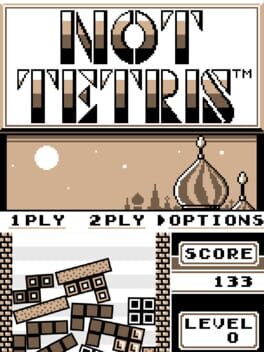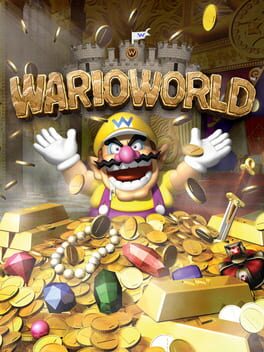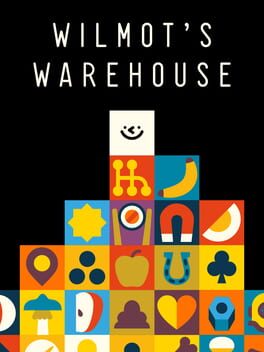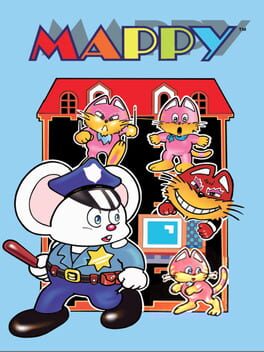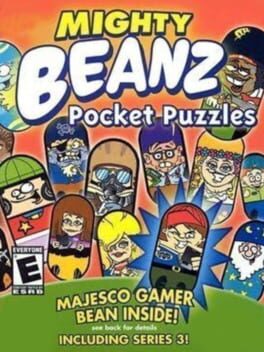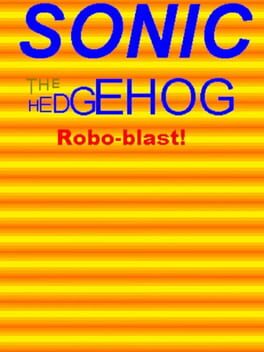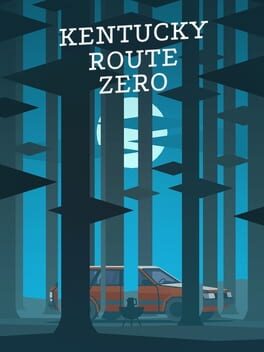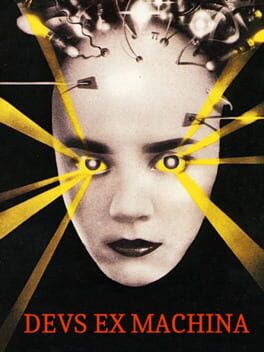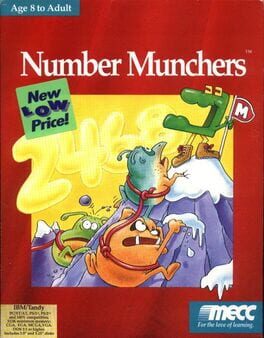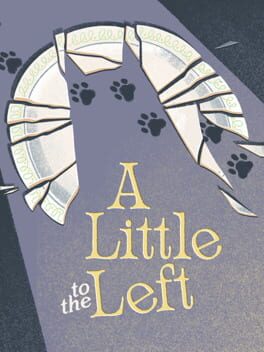vehemently
2011
There are, generally, two modes of Tetris. There is the methodical mode, a game of precision, planning, and geometry. It's the beautiful game, the king's game, where you fit the squares into their rightful place, eliminating line by line, tetromino by tetromino, tetris by tetris, frame by frame, block by block. This is how most of us like to imagine that we play Tetris.
The second mode is a mode of chaos and hubris. A game of failing to spin a single plate. You clumsily misplace a block or, you're managing your board and -- fuck, how are you supposed to fit that piece in here? And from there, you desperately try to dig yourself out of the hole. This is how most of us actually play Tetris.
Tetris tends to ping pong between these two modes of play. Even professional and grandmaster Tetris players will eventually find themselves struggling to manage the eternal avalanche of bricks.
Ostensibly a shitpost, Not Tetris is actually a reinvention of Tetris that highlights its most chaotic mode of play. Instead of the cold precision of a grid, this is the messy physics of rigidbodies. There's no way to play this game and not fuck up constantly. There is no precision. You press one button trying to rotate your piece, and it immediately begins to spiral. And once you place it, odds are its going to topple over eventually. Try to get these pieces straight, fucking try, I dare you. Eventually, it's not a tower with a few nooks and crannies, it's mostly crannies and a few nooks. When you finally manage to clear a line, slices a straight line across the board, with bits and pieces left behind, as you build higher and higher on a mountain of debris. "How did I let it get this bad?", you ask, knowing full well how and why it got this bad.
It's a novelty at first, but you get the creeping sensation of familiarity: you made the mess. Now try and clean it up.
The second mode is a mode of chaos and hubris. A game of failing to spin a single plate. You clumsily misplace a block or, you're managing your board and -- fuck, how are you supposed to fit that piece in here? And from there, you desperately try to dig yourself out of the hole. This is how most of us actually play Tetris.
Tetris tends to ping pong between these two modes of play. Even professional and grandmaster Tetris players will eventually find themselves struggling to manage the eternal avalanche of bricks.
Ostensibly a shitpost, Not Tetris is actually a reinvention of Tetris that highlights its most chaotic mode of play. Instead of the cold precision of a grid, this is the messy physics of rigidbodies. There's no way to play this game and not fuck up constantly. There is no precision. You press one button trying to rotate your piece, and it immediately begins to spiral. And once you place it, odds are its going to topple over eventually. Try to get these pieces straight, fucking try, I dare you. Eventually, it's not a tower with a few nooks and crannies, it's mostly crannies and a few nooks. When you finally manage to clear a line, slices a straight line across the board, with bits and pieces left behind, as you build higher and higher on a mountain of debris. "How did I let it get this bad?", you ask, knowing full well how and why it got this bad.
It's a novelty at first, but you get the creeping sensation of familiarity: you made the mess. Now try and clean it up.
2003
2019
1983
You know, there are a lot of issues with this site we're on, but it does result in a unique sort of exchange in tastes. Periodically checking the front page means I get to learn what other people are playing, what they might think of it, even if I don't know them particularly well. Sometimes, I see some game cross my feed that I've never heard of but piques my interest. Something unorthodox, or unpopular, or new. Maybe an obscure title on an old console, or a niche genre staple, or an independent artist pouring their heart and soul into a little game. This gives me an opportunity to expand my horizons, to discover art I'd maybe never had the thought of looking at, and seeing if I connect with it in the same way my peers do. Regardless of whether I like it or whether I agree, this interplay can be meaningful.
This is not one of those games. Festering convulsion of early aughts emanations, so pungently trapped in a corn-syrup time cube, a stagnant, icy rictus. Gave me bean dysmorphia. Probably caused a war. I don't want a "Majesco Gamer Bean". Fuck this game, fuck me for playing it, fuck whoever put it on my feed, and fuck you for participating
This is not one of those games. Festering convulsion of early aughts emanations, so pungently trapped in a corn-syrup time cube, a stagnant, icy rictus. Gave me bean dysmorphia. Probably caused a war. I don't want a "Majesco Gamer Bean". Fuck this game, fuck me for playing it, fuck whoever put it on my feed, and fuck you for participating
2022
Permit me another formalist critique. When I was talking about this game with others, the subject of Sonic inevitably came up. Now, I have nostalgia for those 16-bit Sonic games, but many people, myself included, feel frustration with those old 2D Sonic games because they “don’t let you go fast”. They throw spike traps in your way, they make you bump into walls, they make you do annoying sliding block puzzles. And it doesn’t help then that getting back up to speed feels incredibly slow sans spindash. But a 2D Sonic Defender dissented. There are people who insist that Sonic was never about going fast, and I find this patently absurd. Speed was a heavy aspect of Sonic’s marketing and it’s incredibly hard to ignore. However, the 2D Sonic Defender changed the angle a bit: it’s not a matter of speed, but of momentum. This seems like a fine distinction, but it’s one that’s worth taking up. Because momentum, rather than speed, doesn’t prioritize the rate at which things happen, but rather the duration and weight of player agency. Momentum is not just speed, but also slowness, and the way we move between them. When a Sonic game throws road spikesin your way as you’re trying to move through a level, and then you have to rev up again, the game robs you of your momentum. At its worst moments, Sonic does not respect your inertia.
So here’s how Freedom Planet 2 takes numerous steps to maintain, respect, and foster your momentum. If nothing else, I think it should be remembered as a game that did this. The first game, Freedom Planet, felt like a serious attempt to turn the elements of those early Sonic games into a game that felt good for players who weren’t prepared to master Sonic’s weird physics and memorize its sometimes uncompromising level design. I think it succeeded at that pretty well, and enjoyed it. But Freedom Planet 2 feels like a step above, creating a new echelon that every game in this lineage is going to have to reckon with. And while I’m a bit of an outsider (I like Sonic but I’m not one of the gremlin crew) as I’ve not been completely dedicated to all those games and their fan projects or things that take it as inspiration, I feel very confident in saying that this game did a better job of allowing me to have fun with inertia than any of the ones I’ve played. Freedom Planet 2 empowers players to harness and control their momentum, and I think it blows every game that inspired it out of the water.
Now, the game does this in a number of ways, with a lot of level design affordances to keep you speedy. (Even the puzzle sections here are snappy and fast.) In fact, almost every other new level mechanic the game springs on you is a way of playing with and transforming inertia. And I could get into specifics there, but I think it would be both tedious to write and read descriptions of levels. So I think the most prominent and immediately understandable way that Freedom Planet 2 powers up your momentum is through its player character design. There’s one thing that every character has that, if it were alone added to a game like this, would be great: the player has a guard button they can simply tap to evade damage. The guard has a marginal impact on your speed, and lets you dodge the knockback and slowdown you’d receive if got hit. So even in the event that you are moving too fast, aren’t prepared, and careen into a laser blast, if you’re quick to dodge (or turn on the auto-guard option in the assist menu!) you won’t suffer that consequence, and your momentum is maintained.
But there’s more! Every character also has a moveset that enables them to quickly gain speed, so even from the get-go, and even if you do get hit, it won’t be long before you’re back to zooming. I played through the game with each character (this is not normal for me, I just think this game is very good) and here is a rundown of how that works
Lilac: Water dragon protagonist. The most straight forward in this sense, Lilac has a super dash that does damage as she rockets off in a straight line, and even bounces off wall in that mode. It reminds me a bit of Epsilon Eagle’s dash. She also has a dive kick, and a spin attack double jump. But a lot of Lilac’s speed comes from that dash and using it right.
Carol: Bad bitch catgirl. Carol’s special throws a disk attack that she can zip to. She also has a little dash she can perform after jumping, but if performed close to the ground before landing, will give her a real boost. Holding down as she runs will also turn her into a little ball of fury and deal damage to what ever she rolls through. She can also snag a motorcycle power up that boosts her speed by a lot, and actually acts as her jump disc!
Milla: Green magic dog scientist. Milla is weird but that weirdness makes her really cool. At first she doesn’t seem to have a lot of speed options. Her jump ability is a flutter jump. Her special is a projectile/shield and her melee attacks dont move her forward. However, when you guard, Milla gains a floating green cube beside her which powers up her projectiles and also completely transforms her melee. Now, her melee unleashes a big column of green energy which does a ton of damage, but more importantly blasts her back. Newton’s third law, fucker. Utilizing this lets you jump higher and move faster. Building speed with Milla is probably best done by summoning a cube, jumping just a little bit, and then blasting behind you to propel yourself forward. Done repeatedly, you can really start zooming, and combined with the flutter, the air time Milla can get is unbelievable.
Neera: Icy nationalist panda knight. Neera works the least for me. She has the tools but they never feel quite right to me. Neera can enter a “Frost Art” mode, when she can freeze enemies, and one of her abilities spawns a bunch of frost spires that she can bounce off of. The main way Neera gains momentum though is by attacking twice. When you attack the second time, in the air or on the ground, Neera gets a boost. This works and you can get some major speed, but feels like her only tool for momentum. Also, she has a spear, but you can’t even pogo with it, which is frankly a crime. Unfortunately, this ends my little list on a down note. The irony is that in most other games Neera would feel like a standout, but in Freedom Planet 2, where all the other girls feel dynamic and snappy, Neera feels a little incomplete.
The result is a game that feels invested and supportive of player inertia, enabling you to zoom around and have fun in its environments. It’s a triumph, and not just for that. There are a lot of reasons this game owns bones beyond this: the soundtrack is full of bops, the spritework is beautiful, it’s got a million cool boss battles, the story gets really serious about colonialism, and also there’s lesbians, too. There’s a reason it’s a GOTY contender. Treasure-tier shit. I’m not even a furry. I just think it rules.
Anyway, please consider playing Freedom Planet 2. It’s very fun and I liked it.
So here’s how Freedom Planet 2 takes numerous steps to maintain, respect, and foster your momentum. If nothing else, I think it should be remembered as a game that did this. The first game, Freedom Planet, felt like a serious attempt to turn the elements of those early Sonic games into a game that felt good for players who weren’t prepared to master Sonic’s weird physics and memorize its sometimes uncompromising level design. I think it succeeded at that pretty well, and enjoyed it. But Freedom Planet 2 feels like a step above, creating a new echelon that every game in this lineage is going to have to reckon with. And while I’m a bit of an outsider (I like Sonic but I’m not one of the gremlin crew) as I’ve not been completely dedicated to all those games and their fan projects or things that take it as inspiration, I feel very confident in saying that this game did a better job of allowing me to have fun with inertia than any of the ones I’ve played. Freedom Planet 2 empowers players to harness and control their momentum, and I think it blows every game that inspired it out of the water.
Now, the game does this in a number of ways, with a lot of level design affordances to keep you speedy. (Even the puzzle sections here are snappy and fast.) In fact, almost every other new level mechanic the game springs on you is a way of playing with and transforming inertia. And I could get into specifics there, but I think it would be both tedious to write and read descriptions of levels. So I think the most prominent and immediately understandable way that Freedom Planet 2 powers up your momentum is through its player character design. There’s one thing that every character has that, if it were alone added to a game like this, would be great: the player has a guard button they can simply tap to evade damage. The guard has a marginal impact on your speed, and lets you dodge the knockback and slowdown you’d receive if got hit. So even in the event that you are moving too fast, aren’t prepared, and careen into a laser blast, if you’re quick to dodge (or turn on the auto-guard option in the assist menu!) you won’t suffer that consequence, and your momentum is maintained.
But there’s more! Every character also has a moveset that enables them to quickly gain speed, so even from the get-go, and even if you do get hit, it won’t be long before you’re back to zooming. I played through the game with each character (this is not normal for me, I just think this game is very good) and here is a rundown of how that works
Lilac: Water dragon protagonist. The most straight forward in this sense, Lilac has a super dash that does damage as she rockets off in a straight line, and even bounces off wall in that mode. It reminds me a bit of Epsilon Eagle’s dash. She also has a dive kick, and a spin attack double jump. But a lot of Lilac’s speed comes from that dash and using it right.
Carol: Bad bitch catgirl. Carol’s special throws a disk attack that she can zip to. She also has a little dash she can perform after jumping, but if performed close to the ground before landing, will give her a real boost. Holding down as she runs will also turn her into a little ball of fury and deal damage to what ever she rolls through. She can also snag a motorcycle power up that boosts her speed by a lot, and actually acts as her jump disc!
Milla: Green magic dog scientist. Milla is weird but that weirdness makes her really cool. At first she doesn’t seem to have a lot of speed options. Her jump ability is a flutter jump. Her special is a projectile/shield and her melee attacks dont move her forward. However, when you guard, Milla gains a floating green cube beside her which powers up her projectiles and also completely transforms her melee. Now, her melee unleashes a big column of green energy which does a ton of damage, but more importantly blasts her back. Newton’s third law, fucker. Utilizing this lets you jump higher and move faster. Building speed with Milla is probably best done by summoning a cube, jumping just a little bit, and then blasting behind you to propel yourself forward. Done repeatedly, you can really start zooming, and combined with the flutter, the air time Milla can get is unbelievable.
Neera: Icy nationalist panda knight. Neera works the least for me. She has the tools but they never feel quite right to me. Neera can enter a “Frost Art” mode, when she can freeze enemies, and one of her abilities spawns a bunch of frost spires that she can bounce off of. The main way Neera gains momentum though is by attacking twice. When you attack the second time, in the air or on the ground, Neera gets a boost. This works and you can get some major speed, but feels like her only tool for momentum. Also, she has a spear, but you can’t even pogo with it, which is frankly a crime. Unfortunately, this ends my little list on a down note. The irony is that in most other games Neera would feel like a standout, but in Freedom Planet 2, where all the other girls feel dynamic and snappy, Neera feels a little incomplete.
The result is a game that feels invested and supportive of player inertia, enabling you to zoom around and have fun in its environments. It’s a triumph, and not just for that. There are a lot of reasons this game owns bones beyond this: the soundtrack is full of bops, the spritework is beautiful, it’s got a million cool boss battles, the story gets really serious about colonialism, and also there’s lesbians, too. There’s a reason it’s a GOTY contender. Treasure-tier shit. I’m not even a furry. I just think it rules.
Anyway, please consider playing Freedom Planet 2. It’s very fun and I liked it.
1994
1994
Within the vast library of verbs afforded to players in games, "to fight" is almost unilaterally prioritized. There are no doubt exceptions (entire genres of them) but the vast majority of games, as far as I know, expect the player to enact some form of violence within it. My dad routinely asks me, "Why are so many games about killing?" I ask him, "Why are so many movies about killing?" But this is usually an evasive maneuver, because the truth is, even compared to film, video games are dripping with violence. This is not intrinsically bad, obviously, but it does often lead to a want for games that explore a less violent verbset. There are so many things we can do in the world, so why must video games always boil down to fighting?
Super Punch-Out!!, meanwhile, is only about fighting. It's not about anything else. After all, it's a boxing game. (Sports video games, coincidentally, are perhaps the most popular non-violent genre.) Most games create elaborate contrivances (also known as "stories") to justify their universe of violence. Boxing needs no justification, because it is, by definition, bouts of unjustified punching.
I'll be honest: I've never really liked sports. It's not a matter of disrespect; it's a combination of personal history and personality. Something in my psychology doesn't really line up with it. (For the record, this extends to e-sports, too. I would love to be able to grok fighting games, but grok them I do not.) I just don't seem to have a competitive bone in my body, and if I do, it's probably broken. Boxing itself can be kind of frightening to me if I think about it too much. Super Punch-Out!! is not only a boxing game, but it's also themed more like professional wrestling, a hobby which unfortunately I cannot help but have an immediate revulsion towards. Li'l Mac's opponents are a rogue's gallery of cartoonish heels themed with mish-mashed stereotypes, ranging widely in degrees of offensiveness and cultural insensitivity.
Despite all that, I love Super Punch-Out!!. Maybe it helps that it's a single player game. I had enjoyed the NES Punch-Out!! as a pre-teen, though I don't think I ever got very far. The series' combat is unique, functioning almost more like a puzzle game. King Hippo, from the NES, is perhaps the best illustration of this; you deliver a well-timed smack to his gaping gob and punch his stomach when his pants are quite literally down. I think everyone who's played these games has one or two opponents that was their own mountain to conquer. For me, they were Macho Man, a tanned body builder from Malibu, and Heike Kagero, a kabuki boxer who attacks you with his hair. (Did I mention this game is basically professional wrestling?) It took me days to take them down, Macho Man with his massive one-hit-KO spins, Kagero with his hair whipping across the screen. Every win is hard fought, and every win is a flush of accomplishment hitting your system.
Again, fighting is literally the only thing you do in this game. Many games, even the most action-heavy, frame their combat within a worldspace, full of ancillary systems. Here, there is no exterior world to explore, nowhere to escape to. There's only boxing. As a result, the boxing of Super Punch-Out!! is actually pretty mechanically dense, especially for the time. The NES version was, comparitively, a bit repetitive and a bit flat, but compared to its contemporaries, it was an incredibly complex combat system. The SNES sequel deepens this further, returning to the depth exhibited in the original arcade game. The deck is completely stacked against you. Li'l Mac is a tiny little twink (albeit ripped), and everyone towers over him. You often end up taking chips off their healthbars while a single blow across your chin will decimate you. It's even got a time limit of three minutes, which means every punch pulled is another inch closer to loss. People sometimes talk about games where "every button press counts", but it really is true here. A single mistimed button press (or even leaving buttons unpressed) by a couple of frames can be the difference between you nailing him with an uppercut, or you finding yourself facedown on the canvas.
Super Punch-Out!! makes me a little embarrassed to be so skeptical of the verb "to fight." I will never stop looking for new kinds of play, but it reveals just how dynamic combat can be, not in spite of it being a game exclusively about fighting, but because of it. The fighting game community, I imagine, is already quite aware of this, and maybe this all seems laughably quaint if you're one of those Platinum game stans, but as a reminder, this game is almost 30 years old, and in the case of the arcade game, 40 years old. Most games, even these days, do not ask for anything close to the amount of mastery and attention Super Punch-Out!! does. It's a very demanding game where every little thing matters. It matters whether you throw a right hook or a left one. Whether you block high or low. Whether you try to hit their face or their chest. Whether you dodge left or right. You have to watch every move your opponent makes. Learn every tell. Know how to precisely counter each one. Get that download complete. Study all their moves. And after you've done all that? Punch them in the face.
Super Punch-Out!!, meanwhile, is only about fighting. It's not about anything else. After all, it's a boxing game. (Sports video games, coincidentally, are perhaps the most popular non-violent genre.) Most games create elaborate contrivances (also known as "stories") to justify their universe of violence. Boxing needs no justification, because it is, by definition, bouts of unjustified punching.
I'll be honest: I've never really liked sports. It's not a matter of disrespect; it's a combination of personal history and personality. Something in my psychology doesn't really line up with it. (For the record, this extends to e-sports, too. I would love to be able to grok fighting games, but grok them I do not.) I just don't seem to have a competitive bone in my body, and if I do, it's probably broken. Boxing itself can be kind of frightening to me if I think about it too much. Super Punch-Out!! is not only a boxing game, but it's also themed more like professional wrestling, a hobby which unfortunately I cannot help but have an immediate revulsion towards. Li'l Mac's opponents are a rogue's gallery of cartoonish heels themed with mish-mashed stereotypes, ranging widely in degrees of offensiveness and cultural insensitivity.
Despite all that, I love Super Punch-Out!!. Maybe it helps that it's a single player game. I had enjoyed the NES Punch-Out!! as a pre-teen, though I don't think I ever got very far. The series' combat is unique, functioning almost more like a puzzle game. King Hippo, from the NES, is perhaps the best illustration of this; you deliver a well-timed smack to his gaping gob and punch his stomach when his pants are quite literally down. I think everyone who's played these games has one or two opponents that was their own mountain to conquer. For me, they were Macho Man, a tanned body builder from Malibu, and Heike Kagero, a kabuki boxer who attacks you with his hair. (Did I mention this game is basically professional wrestling?) It took me days to take them down, Macho Man with his massive one-hit-KO spins, Kagero with his hair whipping across the screen. Every win is hard fought, and every win is a flush of accomplishment hitting your system.
Again, fighting is literally the only thing you do in this game. Many games, even the most action-heavy, frame their combat within a worldspace, full of ancillary systems. Here, there is no exterior world to explore, nowhere to escape to. There's only boxing. As a result, the boxing of Super Punch-Out!! is actually pretty mechanically dense, especially for the time. The NES version was, comparitively, a bit repetitive and a bit flat, but compared to its contemporaries, it was an incredibly complex combat system. The SNES sequel deepens this further, returning to the depth exhibited in the original arcade game. The deck is completely stacked against you. Li'l Mac is a tiny little twink (albeit ripped), and everyone towers over him. You often end up taking chips off their healthbars while a single blow across your chin will decimate you. It's even got a time limit of three minutes, which means every punch pulled is another inch closer to loss. People sometimes talk about games where "every button press counts", but it really is true here. A single mistimed button press (or even leaving buttons unpressed) by a couple of frames can be the difference between you nailing him with an uppercut, or you finding yourself facedown on the canvas.
Super Punch-Out!! makes me a little embarrassed to be so skeptical of the verb "to fight." I will never stop looking for new kinds of play, but it reveals just how dynamic combat can be, not in spite of it being a game exclusively about fighting, but because of it. The fighting game community, I imagine, is already quite aware of this, and maybe this all seems laughably quaint if you're one of those Platinum game stans, but as a reminder, this game is almost 30 years old, and in the case of the arcade game, 40 years old. Most games, even these days, do not ask for anything close to the amount of mastery and attention Super Punch-Out!! does. It's a very demanding game where every little thing matters. It matters whether you throw a right hook or a left one. Whether you block high or low. Whether you try to hit their face or their chest. Whether you dodge left or right. You have to watch every move your opponent makes. Learn every tell. Know how to precisely counter each one. Get that download complete. Study all their moves. And after you've done all that? Punch them in the face.
1998
s-tier kusoge
literally everything you could want from a bad game. goofy art and music, terrible controls, weird cutscenes where sonic says "robuttnik", glitches, broken level design, dreadful difficulty, and near the end of the game there's a shmup section with a midi version of the final countdown. a legendary moment in gaming history.
literally everything you could want from a bad game. goofy art and music, terrible controls, weird cutscenes where sonic says "robuttnik", glitches, broken level design, dreadful difficulty, and near the end of the game there's a shmup section with a midi version of the final countdown. a legendary moment in gaming history.
1998
2013
“An American tragedy. An odyssey of debt, of grief, of broken promises, of hope. A painful, melancholic fable composed of fables and more fables, spreading out and weaving in and out of itself. A dream ebbing back and forth between memory and fantasy. A plea for you to care about something.”
...This was my original review for Kentucky Route Zero. I still think it’s a good description. But on consideration, I feel as though I need to be bold and say it: Kentucky Route Zero is not only one of my favorite games, but one of my favorite things ever made.
This is not an assessment of quality. I am not telling you what to feel. I am telling you how I feel. And Kentucky Route Zero makes me feel a way.
I specifically say “Favorite Thing”, because Kentucky Route Zero doesn’t affect me like a game. When I think about many of my favorite games, I often think of them as games. They are full of mechanics, of challenges, of systems. That’s certainly not all games are, and games can be many things, but in the capacity that they affect me, enchant me, or fascinate me, it is often within this vague category of “game”. But Kentucky Route Zero is different. To call it “my favorite game” and leave it at that misses something. It’s certainly a game, but it doesn’t make me feel the way games usually make me feel. First and foremost, Kentucky Route Zero is a story. It’s unlike most. The main body of this story is a game, but it’s also a multimedia saga. There’s something quintessential permeating my experience of Kentucky Route Zero that transcends that category.
It is a hauntological melancholy. It conjures a world more like a memory than a reality. Kentucky Route Zero tells the story of people who seem familiar but you’ve never met, with jobs that were never really secure, in situations that could never happen, in a version of Kentucky that has never existed. Magical realism constructs a vision not of reality, but of memory, of a sensate fabric that you swear could have been but never was. Americana is a mythic entity made visible, standing in front of me within Kentucky Route Zero, and it’s on its last breaths.
It’s a hopeful story. That doesn’t mean it’s happy. The world around you is a wasteland. Everyone is dying. Everyone is suffering. Everything is weighed down by debt, pulled deep down into pools of darkness. To live is to work, work, and die. Except… there are other ways to live. There always have been. Should we move on? I think the answer is clear. But that doesn’t make the pain go away. We have to be willing to feel both grief and hope in the same breath.
All of its blemishes are dismissable. Fleeting problems with UI, incidentally clunky writing, weird mechanical tangents, overwhelming scope, these melt away when I take a moment to remember what Kentucky Route Zero is and feel the frisson travel up and down my skin. I'm trying to not be too longwinded here, but it's hard. I can't get into specifics. So I wax poetic instead. I could write thousands of words on every minute I spent with Kentucky Route Zero and still feel like I was forgetting to say something. It is a multitudinous masterpiece, refracting and reflecting endlessly, timelessly, quietly.
Kentucky Route Zero is one of my favorite things.
...This was my original review for Kentucky Route Zero. I still think it’s a good description. But on consideration, I feel as though I need to be bold and say it: Kentucky Route Zero is not only one of my favorite games, but one of my favorite things ever made.
This is not an assessment of quality. I am not telling you what to feel. I am telling you how I feel. And Kentucky Route Zero makes me feel a way.
I specifically say “Favorite Thing”, because Kentucky Route Zero doesn’t affect me like a game. When I think about many of my favorite games, I often think of them as games. They are full of mechanics, of challenges, of systems. That’s certainly not all games are, and games can be many things, but in the capacity that they affect me, enchant me, or fascinate me, it is often within this vague category of “game”. But Kentucky Route Zero is different. To call it “my favorite game” and leave it at that misses something. It’s certainly a game, but it doesn’t make me feel the way games usually make me feel. First and foremost, Kentucky Route Zero is a story. It’s unlike most. The main body of this story is a game, but it’s also a multimedia saga. There’s something quintessential permeating my experience of Kentucky Route Zero that transcends that category.
It is a hauntological melancholy. It conjures a world more like a memory than a reality. Kentucky Route Zero tells the story of people who seem familiar but you’ve never met, with jobs that were never really secure, in situations that could never happen, in a version of Kentucky that has never existed. Magical realism constructs a vision not of reality, but of memory, of a sensate fabric that you swear could have been but never was. Americana is a mythic entity made visible, standing in front of me within Kentucky Route Zero, and it’s on its last breaths.
It’s a hopeful story. That doesn’t mean it’s happy. The world around you is a wasteland. Everyone is dying. Everyone is suffering. Everything is weighed down by debt, pulled deep down into pools of darkness. To live is to work, work, and die. Except… there are other ways to live. There always have been. Should we move on? I think the answer is clear. But that doesn’t make the pain go away. We have to be willing to feel both grief and hope in the same breath.
All of its blemishes are dismissable. Fleeting problems with UI, incidentally clunky writing, weird mechanical tangents, overwhelming scope, these melt away when I take a moment to remember what Kentucky Route Zero is and feel the frisson travel up and down my skin. I'm trying to not be too longwinded here, but it's hard. I can't get into specifics. So I wax poetic instead. I could write thousands of words on every minute I spent with Kentucky Route Zero and still feel like I was forgetting to say something. It is a multitudinous masterpiece, refracting and reflecting endlessly, timelessly, quietly.
Kentucky Route Zero is one of my favorite things.
1984
1990
2022
Everything, everything
Everything, everything
In its right place, in its right place
In its right place, in its right place
Yesterday I woke up sucking a lemon, yesterday I woke up sucking a lemon
Yesterday I woke up sucking a lemon, yesterday I woke up sucking a lemon
Everything, everything
Everything
In its right place, in its right place
Right place
There are two colours in my head, there are two colours in my head
What, what is that you tried to say? What, what was that you tried to say?
Tried to say, tried to say, tried to say, tried to say
Everything
Everything
Everything
Everything
Everything, everything
In its right place, in its right place
In its right place, in its right place
Yesterday I woke up sucking a lemon, yesterday I woke up sucking a lemon
Yesterday I woke up sucking a lemon, yesterday I woke up sucking a lemon
Everything, everything
Everything
In its right place, in its right place
Right place
There are two colours in my head, there are two colours in my head
What, what is that you tried to say? What, what was that you tried to say?
Tried to say, tried to say, tried to say, tried to say
Everything
Everything
Everything
Everything
2022
"My objective was solely archaeological. I would hunt these gray forms until they would transmit to me a part of their mystery, a part of the secret few phrases could sum up: why would these extraordinary constructions, compared to the seaside villas, not be perceived or even recognized? Why this analogy between the funeral archetype and military architecture? Why this insane situation looking out over the ocean? This waiting before the infinite oceanic expanse?...
...Why speak of "brutalism"? And, above all, why this ordinary habitat, so very ordinary over so many years?
These heavy gray masses with sad angles and no openings - excepting the air inlets and several staggered entrances - brought to light much better than many manifestos the urban and architectural redundancies of the postwar period that had just reconstructed to a tee the destroyed cities. The antiaircraft blockhouses pointed up another lifestyle, a rupture in the apprehension of the real. The blue sky had once been heavy with the menace of rumbling bombers, spangled too with the deafening explosions of artillery fire. This immediate comparison between the urban habitat and the shelter, between the ordinary apartment building and the abandoned bunker in the heart of the pores through which I was traveling, was as strong as a confrontation, a collage of two dissimilar realities. The antiaircraft shelters spoke to me of men's anguish and the dwellings of the normative systems that constantly reproduce the city, the cities, the urbanistic.
The blockhouses were anthropomorphic; their figures recalled those of bodies. The residential units were but arbitrary repetitions of a model, a single, identical, orthogonal, parallelepipedal model. The casemate, so easily hidden in the hollow of the coastal countryside, was scandalous here, and its naturalness was due less to the originality of its silhouette than to the extreme triviality of the surrounding architectural forms. The curved profile brought with it into the harbor's quarters a trace of the curves of dunes and nearby hills, and there, in this naturalness, was the scandal of the bunker...
...Slowed down in his physical activity but attentive, anxious over the catastrophic probabilities of his environment, the visitor in this perilous place is beset with a singular heaviness; in fact he is already in the grips of that cadaveric rigidity from which the shelter was designed to protect him. "
- Paul Virilio, Bunker Archaeology
...Why speak of "brutalism"? And, above all, why this ordinary habitat, so very ordinary over so many years?
These heavy gray masses with sad angles and no openings - excepting the air inlets and several staggered entrances - brought to light much better than many manifestos the urban and architectural redundancies of the postwar period that had just reconstructed to a tee the destroyed cities. The antiaircraft blockhouses pointed up another lifestyle, a rupture in the apprehension of the real. The blue sky had once been heavy with the menace of rumbling bombers, spangled too with the deafening explosions of artillery fire. This immediate comparison between the urban habitat and the shelter, between the ordinary apartment building and the abandoned bunker in the heart of the pores through which I was traveling, was as strong as a confrontation, a collage of two dissimilar realities. The antiaircraft shelters spoke to me of men's anguish and the dwellings of the normative systems that constantly reproduce the city, the cities, the urbanistic.
The blockhouses were anthropomorphic; their figures recalled those of bodies. The residential units were but arbitrary repetitions of a model, a single, identical, orthogonal, parallelepipedal model. The casemate, so easily hidden in the hollow of the coastal countryside, was scandalous here, and its naturalness was due less to the originality of its silhouette than to the extreme triviality of the surrounding architectural forms. The curved profile brought with it into the harbor's quarters a trace of the curves of dunes and nearby hills, and there, in this naturalness, was the scandal of the bunker...
...Slowed down in his physical activity but attentive, anxious over the catastrophic probabilities of his environment, the visitor in this perilous place is beset with a singular heaviness; in fact he is already in the grips of that cadaveric rigidity from which the shelter was designed to protect him. "
- Paul Virilio, Bunker Archaeology
